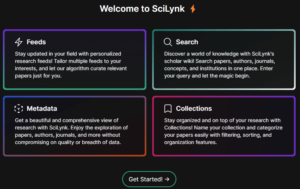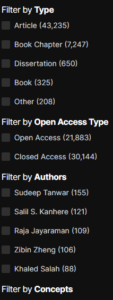As a researcher, finding and organizing relevant research papers can be a time-consuming and daunting task. There is AI-powered search engine available to accelerate your research workflow. In this blog post, I will introduce you to SciLynk, an AI-driven tool that helps you find and organize academic paper more efficiently.
Using AI technology, SciLynk analyzes research papers and extracts key information such as authors, keywords, and citations. Using this information, a personalized research feed is created for each user.
How to Accelerate Your Research Workflow with AI-Powered Search Engine
In this section, I will show you how to use Scilynk AI search engine to find and organize research paper more efficiently with step by step instructions.
Here is a step-by-step guide to using SciLynk AI:
To begin with, you launch the SciLynk website. As soon as you open the website, the screen below will appear:

In order to use SciLynk, you will need to register and set up an account to proceed. You can sign up for a free account on the website.
After signing in to the web application, the interface will be readily available for your use:

Now, simply click on “Get Started” button and proceed to select a topic to create your personalized “feed”.
Once you click on the button, the pop up window below will appear:

After accessing the platform, you will be directed to generate a new feed. In my case, I opted for the name “OER”
The feed you will come across is as follows:

You have the option to filter results based on article, dissertation, and book chapters. Besides, you can filter by authors, open access type and concepts.

You can also refine your search results by including the name of relevant journals as keywords when you create a feed. SciLynk will give you articles from those journals that match your search query.
Additionally, you have the flexibility to generate multiple feeds to accommodate various domains.
The cutting-edge tool allows you to create collections for saving your research papers.
To do this, simply click on the folder button located in the left taskbar and create a collection. You will see the below popup:

Once you find the academic papers you need for your research project, you can simply organize them into collections for easy access and management.
Multiple collections can be created for different topics or purposes. You can also add notes and tags to your collections for easy reference.
You can sort and filter through your collections to find the paper you are looking for in seconds. Collections can also be exported to BibTeX format. It allows for seamless integration with your preferred reference manager.
If you wish to, you can perform the following operations on your “feed.”
i. Import ii. Export iii Edit iv. Delete
The functions of operation are presented in the following snapshot:

SciLynk lets you collaborate with other scholars by sharing papers and folders. You can also create groups to collaborate on specific projects.
One of the coolest features of Scilynk is Lynx AI, your personal AI research assistant that will summarize search results and key findings to distill complex concepts at a glance.
I previously covered the Lynx AI tool in my blog post “10 AI Tools for Research Paper Summarization.”
You can also view the concept linking for any result, which shows you the related concepts for that entity.
To experience it firsthand, head over to the SciLynk’s website now and start finding the relevant articles. Also, remember to share this blog post with your fellow scholars who could benefit from it too!














